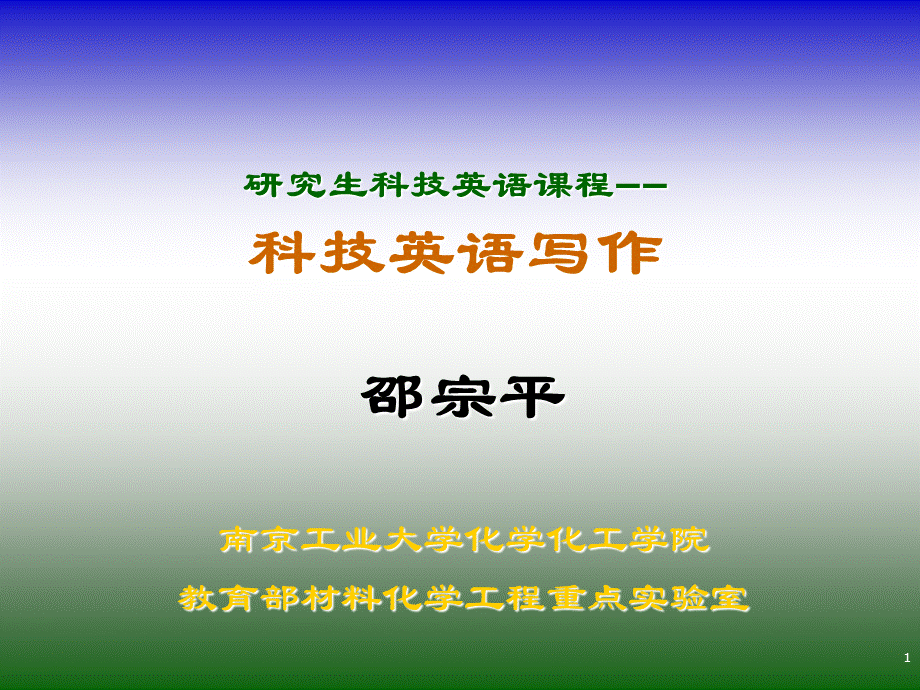科技英语与英语科技论文写作三PPT文档格式.ppt
《科技英语与英语科技论文写作三PPT文档格式.ppt》由会员分享,可在线阅读,更多相关《科技英语与英语科技论文写作三PPT文档格式.ppt(41页珍藏版)》请在冰点文库上搜索。

Discussion?
透过现象看本质,Results,Discussion,9,结果与讨论HowtowritetheResults&
一、结果与讨论分开写二、结果与讨论合在一起写,10,结果与讨论一、结果与讨论分开写Example1Example2Example3,11,结果与讨论一、结果与讨论分开写结果部分的写法,12,实验结果描述,Youshouldpresentrepresentativedataratherthanendlesslyrepetitivedata.ToHandleNumbers:
Ifoneoronlyafewdataaretobepresented,theyshouldbetreateddescriptivelyinthetext.Moredatashouldbegivenintablesorgraphs.ThewholepapermuststandonthebasisoftheResults.Thus,theResultsmustbepresentedasclearaspossible.,13,实验结果描述,http:
/在结果的提供上,主要是表格和图两种方式。
14,实验结果描述,http:
/,15,实验结果描述,http:
/,16,结果与讨论一、结果与讨论分开写讨论部分的写法Example1Example2Example3,17,讨论部分,TheprimarypurposeoftheDiscussionistoshowtherelationshipsamongobservedfacts.Story1Aftertrainingthefleaformanymonths,thebiologistwasabletogetaresponsetocertaincommands.Themostgratifying令人满意的oftheexperimentswastheoneinwhichtheprofessorwouldshoutthecommand“Jump,”andthefleawouldleapintotheaireachtimethecommandwasgiven.Theprofessorwasabouttosubmitthisremarkablefeat技艺toposterity后世viaascientificjournal,butheinthemannerofthetruescientistdecidedtotakehisexperimentsonestepfurther.,18,讨论部分,Heplannedtodeterminethelocationofthereceptororganinvolved.Inoneexperiment,heremovedthelegsoftheflea,oneatatime.Thefleaobligingly亲切地continuedtojumpuponcommand,butaseachsuccessivelegwasremoved,itsjumpsbecamelessspectacular壮观.Finally,withtheremovalofitslastleg,theflearemainedmotionless.Timeaftertimethecommandfailedtogettheusualresponse.,19,讨论部分,Theprofessordecidedthatatlasthecouldpublishhisfindings.Hesetpentopaperanddescribedinmeticulous小心翼翼的detailtheexperimentsexecutedovertheprecedingmonths.Hisconclusionwasoneintendedtostartle震惊thescientificworld:
Whenthelegsofafleaareremoved,thefleacannolongerhear.,20,讨论部分,TheDiscussionisusuallythehardestsectiontowrite.ManypapersarerejectedbyjournaleditorsbecauseofafaultyDiscussion,eventhoughthedataofthepapermightbebothvalidandinteresting.Evenmorelikely,thetruemeaningofthedatamaybecompletelyobscuredbytheinterpretationpresentedintheDiscussion,againresultinginrejection.,21,讨论部分,WhataretheessentialfeaturesofagoodDiscussion?
1.Trytopresenttheprinciples,relationships,andgeneralizations归纳shownbytheResults.2.Pointoutanyexceptionsoranylackofcorrelation;
Defineunsettledpoints;
Nevertrytocoveruporfudge回避thedatathatdonotquitefit.3.Showhowyourresultsandinterpretationsagree(orcontrast)withpreviouslypublishedwork.4.Dontbeshy;
discussthetheoreticalimplicationsofyourwork,aswellasanypossiblepracticalapplications.5.Stateyourconclusionsasclearlyaspossible.,22,讨论部分,“Finally,goodwriting,likegoodmusic,hasaclimax高潮.Manyapaperlosesmuchofitseffectbecauseitends“Notwithabang巨响butawhimper呜咽.Donotextrapolate外推toabiggerpicturethanthatshownbyyourdata.,23,讨论部分,讨论的内容主要有:
http:
/
(1)回顾研究的主要目的或假设,并探讨所得到的结果是否符合原来的期望?
如果没有的话,为什么?
(2)概述最重要的结果,并指出其是否能支持先前的假设以及是否与其他学者的结果相互一致;
如果不是的话,为什么?
(3)对结果提出说明、解释或猜测;
根据这些结果,能得出何种结论或推论?
(4)指出结果的理论意义(支持或反驳相关领域中现有的理论、对现有理论的修正)和实际应用。
24,讨论部分,http:
/,25,讨论部分,http:
/,26,讨论部分,要从多个角度展开深入的讨论。
首先要有类似结果的对比,说明自己结论的独特性。
其次要阐述为什么会有这样的结果,将这个问题阐述清楚,不能让人有意犹未尽之感。
如果你发现某个问题很重要,觉得稿件评阅人和读者读了你的文章肯定会提出这个问题,不幸的是你的实验结果又无法给出明确的yes-or-no,这时最好的方法是勇敢面对,写作时点出这个问题,并说明这个问题itisstillunclear,thisquestionremainsopen,underinvestigation,tobedemonstrated等等,于是审稿人知道你已经意识到了这个问题,不再刁难你。
如果审稿人正好对此有研究,他也会对你指导一二。
例如:
原稿,修改稿。
27,讨论部分,http:
/,28,注意随时比较你的实验结果与文献类似结果的异同。
同则使你的结果更让人信服,异要加以分析。
在与文献结果对比和分析的时候,一定要表现出对作者充分的尊重,绝不可以使用贬低别人的词汇。
如果与结果完全不同,你分析不出为何有此差异,而且对自己的结果有信心,于是可点出此差异,且告诉读者原因不明。
这也是一种勇敢和有信心的表现。
真正的科学不怕质疑。
在质疑别人的结果时,可以采用如下方式:
指出他的发现,然后告诉读者这些发现在你的实验结果中was(were)notobserved.只要你认为正确,就要坚持你的观点。
讨论部分,29,当你的结果与文献结果相同时,也要分析原作者对实验现象的解释是否合理。
例如掐掉跳蚤的腿时,大家都发现跳蚤不再听从召唤,但不能解释成“跳蚤的耳朵在腿上”。
你应根据自己的实验结果予以质疑,最好同时佐以文献结果,先破后立,提出自己的见解。
Example,讨论部分,30,在讨论中应选择适当的词汇来区分推测与事实。
例如,选用show,indicate,found,observed,reveal,exhibit,seen等表示作者所观察到的事实;
选用imply,suggest,beattributedto,beassignedtobeelucidated,beinterpreted等表示推测或推断;
选用“can”,“could”,“will”,“would”,“should”,“must”,“may”,“might”,“obviously”,“probably”,“possibly”,“perhaps”,“seem”,“likely”,“mostlikely”,“approximately”,“certainly”,“roughly”,等来表示论点的确定性程度。
“agree”,“consistentwith”,“coincidewith”表示与相一致。
讨论部分,31,结果与讨论二、结果与讨论合并ResultsandDiscussion,32,结果与讨论合并,一般认为,合并写要比分开写更容易。
合在一起写的优点是文章更紧凑。
每叙述一个实验结果,就可以对此加以讨论,这样读者会有一气呵成的感觉。
叙述第二个实验结果时,要及时分析它和第一个实验结果有无相互支持和矛盾之处。
叙述第三个实验结果时,要及时分析它和第一、二个实验结果有无相互支持和矛盾之处。
后面依次类推。
注意随时比较你的实验结果与文献类似结果的异同。
如果相同则使你的结果更让人信服,如果不同,你也要加以分析。
Example;
Example;
33,如何写结论?
HowtowritetheConclusion?
34,如何写结论?
尽管结论里的内容都已包含在“结果与讨论”或“讨论”中,但多数情况下将“结论”单独列出来作为一节。
个别论文无结论部分。
在“结论”中作者应清楚、简洁地叙述自己研究的主要论点。
不能叙述不重要或与自己研究没有密切联系的内容。
撰写结论时不应涉及前文不曾指出过的结果;
应用总结性语言,尽量不要在结论中重复论文其它部分中的句子。
结论中的论点也可编号列出。
35,如何致谢?
HowtowritetheAcknowledgement?
36,如何致谢?
Anysignificanttechnicalhelpthatyoureceivedfromanyindividual,whetherinyourlaboratoryorelsewhere.Example:
ThanksareduetoJ.JonesforassistancewiththeexperimentsandtoR.Smithforvaluablediscussion.“Wethank.”Youshouldalsoacknowledgethesourceofspecialequipmentorothermaterials.Anyoutsidefinancialassistance,suchasgrants,contracts,orfellowships.中文论文一般没有单独的致谢,但用footnote脚注。
37,如何引用参考文献?
HowtocitetheReferences?
38,如何引用参考文献?
言必有据。
除了公认的常识性知识之外,只要不是作者自己的工作,都要标明出处。
即使是作者自己以往的工作,也要列出相应的文献。
一些作者在论文中引述相当数量公式,但却不列出公式的出处,让读者分不清是作者发展的,还是引自他人以往的工作。
这样做,既是对他人研究的充分肯定,免去剽窃之嫌,又说明自己的论述依据充分,同时也突出了自己在该项研究中独创部分。
39,如何引用参考文献?
Trytolistonlysignificant,publishedreferences.ApaperthathasbeensubmittedoracceptedforpublicationcanbelistedinReferences,citingitassubmittedforpublication,AcceptedorInpress.Evenifyouknowthatthejournaltowhichyouplantosubmityourmanuscriptusesashortform(noarticletitles,forexample),youwouldstillbewisetoestablishyourreferencelistinthecompleteform.,40,如何引用参考文献?
Reasons:
(1)Thejournalyouselectedmayrejectyourmanuscript,resultinginyourdecisiontosubmitthemanuscripttoanotherjournal,perhapsonewithmoredemandingrequirements;
(2)Itismorethanlikelythatyouwillusesomeofthesamereferencesagain,inlaterresearchpapers,reviewarticlesorbooks.,41,如何引用参考文献?
Whenyousubmitamanuscriptforpublication,makesurethatthereferencesarepresentedaccordingtotheInstructionstoAuthors.Ifthereferencesareradically根本上地different,theeditorandrefereesmayassumethatthisisasignofpreviousrejectionor,atbest,obviousevidenceoflackofcare.Thereferenceshouldbeplacedatthatpointinthesentencetowhichitapplies.列举某人的观点时,文献最好紧接在人名之后。